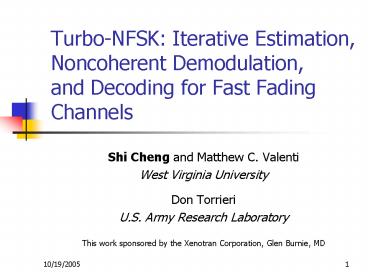Turbo-NFSK: Iterative Estimation, Noncoherent Demodulation, and Decoding for Fast Fading Channels - PowerPoint PPT Presentation
Title:
Turbo-NFSK: Iterative Estimation, Noncoherent Demodulation, and Decoding for Fast Fading Channels
Description:
BER of 16-ary NFSK in Rayleigh Fading Channel with Different Block Size BER of NFSK in Rayleigh Fading Channel with Different Alphabet Size BER of 16-ary NFSK in ... – PowerPoint PPT presentation
Number of Views:123
Avg rating:3.0/5.0
Title: Turbo-NFSK: Iterative Estimation, Noncoherent Demodulation, and Decoding for Fast Fading Channels
1
Turbo-NFSK Iterative Estimation, Noncoherent
Demodulation,and Decoding for Fast Fading
Channels
- Shi Cheng and Matthew C. Valenti
- West Virginia University
- Don Torrieri
- U.S. Army Research Laboratory
- This work sponsored by the Xenotran Corporation,
Glen Burnie, MD
2
Outline
- Iterative M-ary NFSK demodulation and decoding
- ML estimator using EM algorithm
- Performance of iterative estimation, NFSK
demodulation and decoding - Methods to reduce the complexity of the estimator
- Conclusions
3
BICM-ID Bit Interleaved CodedModulation with
Iterative Decoding
Binary to M-ary mapping
Binary Encoder
Bitwise Interleaver
M-ary- modulator
Complex flat-fading
AWGN
Soft-In Binary Decoder
LLR Bit Metric Calculation
Receiver front end
Bitwise Deinterleaver
Bitwise Interleaver
Soft-Output Estimates of Coded Bits
4
Noncoherent M-FSKUsing A Priori Probabilities
- Bit LLRs are calculated based on the channel
observation and the extrinsic information
feedback from the decoder - Where
5
BICM ID and CM Capacity
BICM ID Performance using CDMA2000 length 6138
codeword 20 iterations, BER 10-4
Reference M.C.Valenti and S. Cheng, Iterative
demodulation and decoding of turbo coded M-ary
noncoherent orthogonal modulation IEEE Journal
on Selected Areas in Communications, Sept. 2005.
Minimum Eb/No (in dB)
Code Rate R
6
Block Fading Channel
- Fading coefficient is fixed within one block.
- Independent fading from block to block
2
192
3
1
...
0
767
4
8
N
4
1
2
96
...
0
767
8
N
8
CDMA 2000 turbo codeword rate ½ length 1530 with
16-NFSK
7
Estimation of One Block
- Channel state information is needed to calculate
bit LLRs - Perform estimation of A and B independently block
by block, where
Soft-In Binary Decoder
LLR Bit Metric Calculation
Bitwise Deinterleaver
Channel Estimator
Bitwise Interleaver
8
Channel Estimator with Known Transmitted Sequence
- Form the log-likelihood function based on the
known sequence d d0,d1,,dN-1 of - Solving A and B to maximize L
- Where
9
ML Estimator with A Priori Information of the
Sequence
- The sequence d is never known.
- Form log-likelihood function based on the a
priori information of d - Too complex to find the solution to maximize this
function. We resort to EM algorithm.
10
ML Estimator using EM Algorithm
- 0. Select
- 1.
- 2.
- 3.
Normalization factor
Outer Iteration
Inner Iteration
11
BER of 16-ary NFSK in Rayleigh Fading Channel
with Different Block Size
0
10
N32
CDMA2000 Turbo Code, Rate ½, Length
1530 Independent Block Fading Iteration 20
N16
N8
-1
N4
10
N1
-2
10
BER
-3
10
Estimator
-4
Perfect CSI
10
5
5.5
6
6.5
7
7.5
8
8.5
9
9.5
10
Eb/No (dB)
12
BER of NFSK in Rayleigh Fading Channel with
Different Alphabet Size
0
10
CDMA2000 Turbo Code, Rate ½, Length 1530 Data
Rate 24bits/ block
M2
M4
M16
Iteration 20
-1
M64
10
Estimator
-2
10
BER
Perfect CSI
-3
10
-4
10
4
5
6
7
8
9
10
11
12
Eb/No (dB)
13
BER of 16-ary NFSK in Rician Fading Channel
(K10dB)
Estimator
BER
Perfect CSI
CDMA2000 Turbo Code, Rate ½, Length
1530 Independent Block Fading
Iteration 20
Eb/No (dB)
14
Methods to Reduce the Complexity of the Estimator
- 0. Select
- 1.
- 2.
- 3.
Making hard decision
Outer Iteration
Normalization factor
Inner Iteration
Linear approximation of F
15
Methods to Reduce the Complexity of the Estimator
- 0. Select
- 1.
- 2.
- 3.
Making hard decision
Outer Iteration
Linear approximation of F
16
Linear Approximation of F
17
Complexity of Different Estimators
7
x 10
3
EM estimator
2.5
CPU Cycles/BICMID iteration
16-ary NFSK, CDMA2000 turbo codeword with rate ½
and length 1530. N4 symbols per block
independent Rayleigh fading
2
Decoder
1.5
Hard Linear EM
Demodulator
1
Linear EM
0.5
0
5.6
5.8
6
6.2
6.4
6.6
6.8
7
Eb/No (dB)
18
BER Performance of Low Complexity Estimators
16-ary NFSK, CDMA2000 turbo codeword with rate ½
and length 1530. N4 symbols per block,
independent Rayleigh fading, iteration 20
BER
Eb/No (dB)
19
Conclusions
- Robust noncoherent channel estimator, dealing
with severe channel conditions. - The estimator works without needing to know the
fading statistics model. The only requirement is
the coherence time of the fading amplitude is
larger than 4 symbols. - Although the estimator using the exact EM
algorithm is complex, linear approximation of
F(x) I1(x)/I0(x) and hard decision of can
be used to reduce the comlexity. - For 16-NFSK, when fading block size is larger
than 4 symbols per block, the system has
acceptable BER performance. - When there are 4 symbols per block, the BER of
the iterative estimation, demodulation and
decoding is about 0.60.8dB away from the one
with perfect CSI.






























